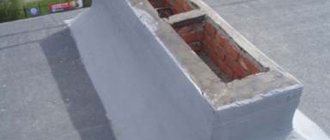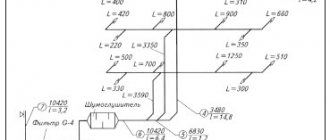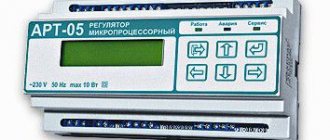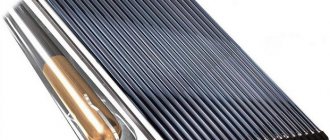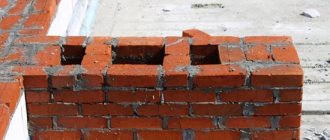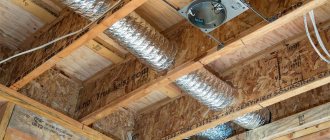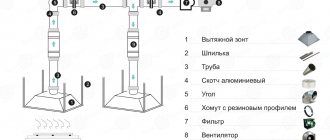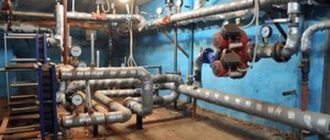In multi-apartment buildings, the presence of a ventilation system with a natural impulse for air circulation is a necessary condition, without which a residential building will not be put into operation.
However, in private construction, the organization of air exchange is often remembered only with the appearance of unpleasant odors and fungal mold on the walls. A well-designed ventilation scheme in a private home will help solve this problem.
In this material we will talk about the features of natural and forced ventilation and the principles of its functioning. And also about how to correctly design an air exchange system in a private house.
Why does a building need ventilation?
The use of modern materials and various external enclosing structures of a cottage/house in construction complicates the natural air exchange between rooms and the street, and sometimes even blocks it. Thanks to internal and external insulation and installed plastic windows, buildings become airtight.
Such measures help preserve heat and save energy resources, but greatly impede the flow of fresh air. To correct this typical situation, it is necessary to organize an effective air circulation system.
In a building, ventilation is needed so that fresh air regularly enters the bathroom, bedroom, living room and kitchen, not through open windows and doors, but through special devices - anemostats and air diffusers.
According to generally accepted sanitary and hygienic standards, a properly functioning ventilation system is a mandatory element of the engineering equipment of all residential buildings
A constant flow of air into the house will provide comfortable conditions for long-term living of people and maintenance of plants, as well as for the full functioning of all technical systems.
Ventilation is also necessary to maintain optimal environmental parameters for the safe operation of various building structures, wooden furniture and interior items.
The circulation of air flows must be organized not only in living rooms, but also in utility rooms - bathrooms and toilets, in the kitchen, in the boiler room and basement.
A high-quality ventilation system helps quickly remove excess moisture and heat. Along with the exhaust air, harmful microorganisms, accumulated dirt and dust are simultaneously removed from the premises.
Organizing the outflow of polluted air is a preventive measure in the difficult fight against fungus and mold
That is why it is important, even at the design stage of a residential building, to think through all the details of the utility network: make the ventilation in the kitchen more powerful than in other rooms, correctly select the functional elements of the ventilation system to ensure an optimal level of oxygen in the interior.
Methods for organizing air exchange in the house
There are different ways to ensure air exchange in a residential building - from periodically briefly opening doors and windows to installing multifunctional systems for preparing and delivering clean air to each room.
From the point of view of ventilation, a healthy and comfortable atmosphere in the house is formed not only due to the composition of the air. Its temperature, uniformity of distribution and mobility play an important role.
The influx of cool air can create a powerful convection current, which will be perceived by humans as an unpleasant draft. As a result, even at normal temperatures the room will be uncomfortable.
In old brick buildings, ventilation and aeration were provided by special vents left during the construction of a residential building
The ventilation system in the cottage kitchen, made from wooden beams, also seemed as simple as possible. Leaky doorways and window blocks contributed to the continuous circulation of air currents in the house.
All these methods are still used today in small one-story buildings. There is quite enough natural air ventilation there. But if we talk about large and spacious private houses, then it is impossible to do without additionally installed central air conditioners and fans.
Types of ventilation systems
According to the basic requirements of hygienic and sanitary standards, the ventilation performance of any type should be:
- 3 m3 per hour per 1 square meter of area for living rooms;
- 25 m3 for separate sanitary facilities;
- 50 m3 for sanitary facilities.
The amount of fresh air that needs to be supplied to different rooms depends on a number of other factors - the number of people, the nature and frequency of work performed, the concentration of harmful substances.
In residential premises, 35 m3 of air is introduced per adult, for children under 10 years of age the norm is 15-20 m3 per hour, for children slightly older - 25 m3.
A designed ventilation scheme in compliance with these parameters will guarantee a regular, stable flow of fresh air and comfortable living in a private home.
There are three types of air exchange systems:
- natural - with a natural impulse to circulate air flows;
- mechanical - with forced air supply and exhaust;
- combined - with partial use of mechanical exhaust and the natural supply of fresh air masses.
It is necessary to organize a continuous automatic supply of clean air in the house. Only the intensity of inflow and removal can change.
The most economical and convenient to operate is a natural ventilation system that functions smoothly without electricity.
But on the other hand, the forced mechanisms involved greatly simplify the ventilation of residential and auxiliary premises.
Read on to learn how to correctly calculate the ventilation system for your home.
Calculation of ventilation systems
Calculating room ventilation at the first stage requires the correct selection of equipment that will have the necessary performance characteristics regarding the amount of air passed through (cubic meter/hour).
It is also considered very important to consider such a parameter as the air exchange rate. It characterizes the number of complete air changes within one hour inside a building
In order to correctly determine this parameter, it is necessary to take into account the norms and regulations of construction. The multiplicity depends on the purpose of using the room, what is in it, how many people, etc.
Calculating the ventilation of industrial premises according to this indicator also involves taking into account the equipment, as well as the characteristics of its operation and the amount of heat or moisture that it emits. For premises intended for human habitation, the air exchange rate is 1, and for industrial premises up to 3.
The brevity metrics generate a performance value that can be as follows:
- from 100 to 800 m³/h (apartment);
- from 1000 to 2000 m³/h (house);
- from 1000-10000 m³/h (office).
Also, air distributors must be designed and installed correctly. These include special air distributors, air ducts, turns, adapters, and so on.
Ensuring reliable and proper ventilation is an extremely important and necessary system in any building.
Natural ventilation in the house
To organize natural air exchange, the concept of vertical ventilation ducts is used. One end is mounted indoors, and the other is brought out slightly above the roof of the building.
Since the air temperature in the house usually differs from the outside temperature, warm currents gradually rise through the exhaust duct. A fresh portion enters the rooms from the external space through window and door blocks.
The performance of the natural ventilation scheme depends on factors beyond human control - wind and ambient temperature
Among the main advantages of such a system are simplicity and minimal costs for arrangement, saturation of rooms with natural air, and independence from electricity.
But there are also significant disadvantages. Thus, natural ventilation in a private building will only work until the air temperature outside exceeds 12 degrees Celsius. At high rates, the hood will not be able to work fully.
At first glance, this situation seems ideal for winter, but there is a drawback that simply cannot be ignored. If there is a significant temperature difference between the outside and indoor air, the system will start working faster. All the heat will literally fly freely into the chimney.
Therefore, residents of cottages and private houses spend more energy resources on heating than normal climatic conditions require.
Unstable operation in summer is the main disadvantage of the natural ventilation scheme
To organize a ventilation system of this type, separate air ducts are laid from each utility room into a common shaft. From the kitchen you need to lay two channels - one from the exhaust grille under the ceiling, and the other from the kitchen hood.
It is also necessary to pay special attention to all rooms completely/partially located below ground level in the house. Toxic radon accumulates in them. To reduce the amount of dangerous gas, a powerful exhaust duct should be installed.
In addition, you need to take care of reliable waterproofing of the basement. After all, even the most effective supply and exhaust system will not cope with its tasks if the basement of a private house or cottage is always damp.
How can you improve efficiency?
There are several ways to help improve the performance of a naturally driven air exchange system:
- install a special valve at the entrance to the channel;
- install grilles with valves on the inflow and outflow channels;
- use a deflector.
The valve, equipped with automation, responds to even slight changes in air humidity. It is mounted at the entrance to the air duct inside the building. When the humidity in the room increases, the automatic relay is activated and the internal valve opens the channel more.
If the indicators decrease, the device closes the entrance. The sensitive element is a sensor that picks up signals from the environment. It is installed outside the house.
In winter, the valve must be additionally closed. This will minimize the entry of cold air into the residential building. However, installing such a device will not cover all the shortcomings of natural ventilation.
Exhaust ventilation ducts are installed in the main internal walls of the building. It is advisable to combine air ducts into small groups so that the passage through the roof is organized in one pipe
Another effective method is to install grilles with valves on the channels for the inflow and removal of air masses. They can only be controlled manually. The valve position must be adjusted at least once a season, when the outside air temperature changes.
Wind can also increase draft in exhaust vertical ducts. To use natural force, a deflector is placed on the top of the pipe - a special device that protects the air duct from debris and precipitation, and also increases draft.
The use of a deflector allows you to increase the performance of the chimney/ventilation duct by 20%
The deflector splits one air stream into two or even more at different speeds. It creates a vacuum, which, in turn, increases the pressure drop in the pipe. As a result, the duct extracts exhaust air better.
Do-it-yourself ventilation device in a private house
Step #1 Calculations
To find out the power of the system, a parameter such as air exchange is calculated. It is calculated for each room separately using the formula:
Р=VхK, where
V – volume of the room (cubic m), calculated by multiplying the width, length and height of the room;
K – standards for minimum air exchange in rooms approved by SNiP 41-01-2003 (cubic m/h). For residential areas - 30, separate sanitary rooms - 25, combined - 50, kitchens - 60-90.
Also, when calculating the ventilation system of a private house, other indicators are taken into account:
- The number of people permanently staying in the house. One person needs 30 cubic meters. m/h of air.
- The thickness of the walls of the premises.
- Number of household and computer equipment.
- Glazing area.
- The location of the building relative to the cardinal directions.
- The presence (absence) of the prevailing wind in this area.
- The presence of a swimming pool in the building. It is recommended to carry out a separate system for it.
Step No. 2 Natural ventilation: improving parameters
Natural ventilation in a private home does not always cope with its task of maintaining the specified temperature and humidity parameters. Then, it is advisable to “modify” the system.
The principle of a ventilation system in a two-story private house
Window supply valves will help with this. They will not depressurize the window, but will create an influx of fresh air. Installing them is simple, following the instructions, even a completely ignorant person can handle it. The principle is that an extended device (350 mm) is mounted on the top of the sash. From this place, the standard seal is cut off and installed from the delivery kit (the narrower one).
A few more devices that improve air circulation. In order not to block the flow of air, ventilation grilles are installed on all interior doors. You cannot “block” the process of mixing the cold air of the window and the warm radiator with a window sill that is too wide.
If a natural ventilation system is designed during the construction of a house, then the following nuances should be taken into account: there should be no rooms without windows in the house; the key to good ventilation is the windows facing all sides of the building ("blank" walls are excluded).
Step No. 3 Supply and exhaust ventilation systems
The installation of fresh air ventilation in a private house is solved using a wall ventilator. It is a telescopic or flexible pipe, on one side (outer) of which there is a decorative grille with a mosquito net (from midges and mosquitoes), on the other (inner) there is a fan and filter.
Recuperator for ventilation system
Supply ventilation in a private house, mounted in the wall in this way:
- Using appropriate equipment, a hole of the required diameter is punched.
- A pipe with insulation is inserted into it.
- The device itself, consisting of a fan, a filter, is mounted on the adhesive solution; some models are equipped with an ionizer.
- Connection to the electrical network.
- A decorative cover is installed on the street side to protect against rain and snow getting inside, and a decorative grille is installed on the inside.
The exhaust ventilation scheme in a private house, with good natural inflow, may consist of fans installed in sanitary rooms and in the kitchen. A wall exhaust fan in the kitchen is installed in the same way as a supply fan. In the sanitary room, either axial or duct is installed in the ventilation duct.
The hood in the kitchen above the stove will also be an additional exhaust duct. If the exhaust ventilation works more intensively than the supply ventilation, the house will become suffocating.
Step No. 4 Do-it-yourself ventilation in a private house diagram
The most optimal ventilation option for a private home is supply and exhaust with mechanical drive. Two types of its designs are used: typesetting and monoblock.
Energy-saving ventilation duct device
The ventilation diagram in a private house of a monoblock system looks something like this:
- air from the street, through the supply air duct, enters the recuperator;
- cleared of harmful atmospheric impurities;
- heats up to the required temperature;
- then, through the air duct, it enters all rooms of the house;
- the exhaust air enters the recuperator through the exhaust pipeline;
- gives up its heat to the incoming cold air;
- from the recuperator, through the exhaust pipe - into the atmosphere.
Features of forced air exchange
If natural ventilation does not provide complete air renewal, a powerful supply and exhaust system is installed in a private house.
It helps balance the air currents that circulate between rooms and the outside environment continuously. Such ventilation guarantees a stable supply of purified fresh air and removal of contaminated air.
Description of mechanical ventilation option
Modern multifunctional supply and exhaust ventilation units make maximum use of the energy of the supplied air flows and convert it into heat.
Such systems deeply clean the supply air, completely filtering it from dust, various allergens, bacteria and other harmful microorganisms.
Additional processing is created using filtration equipment, highly effective noise absorbers, ionization and humidification devices, and sometimes flavoring devices are used.
Air flows that have been processed are distributed throughout the house through special ventilation ducts. Prepared clean air enters the bedroom and children's room, office, living room, kitchen and bathrooms, auxiliary rooms, and is removed from there by an exhaust system
The functional elements of a system with forced air exchange are filters and recuperators, fans, hoods, control devices and, directly, the ventilation unit.
Built-in electronics make it possible to selectively set optimal user operating modes of the system in terms of temperature and humidity, and over time. Remote controls and smart controllers greatly simplify operation.
Mechanical ventilation helps prevent the formation of unpleasant odors in the kitchen, prevents the appearance of dampness and the spread of multi-colored mold, solves the problem of constant humidity in the bathroom and condensation on the surface of the heated floor, double-glazed windows, and door blocks.
Powerful units with integrated filters, special noise absorbers and heaters take up a lot of space. To place them, you need to free up space in the attic or basement of a private house
Modern multifunctional forced ventilation systems are often combined with intelligent control and monitoring systems. Such measures optimize the operation of the equipment of all installed engineering systems in the house and make it possible to organize user-friendly remote control of equipment via the Internet.
Mechanical ventilation with heat recovery
In schemes with heat recovery, a stationary supply and exhaust unit is responsible for air exchange in the building. Air from the environment enters the system, after which it is cleaned of dust and impurities by a filter and sent for main heating to the recuperator.
The air masses are heated to the required temperature in an electric/water heater and distributed throughout the house through durable galvanized steel ventilation ducts.
A heat recovery system will ensure high air quality in a residential building all year round. At low speeds of operating fans, supply and exhaust stationary units operate almost silently.
Automation makes it possible to flexibly control the operation of equipment: regulate air flow, set a comfortable temperature, change the speed of air flows.
Recuperation is the rational use of thermal energy of exhaust air for subsequent heating of supply air. This allows you to reduce up to 85% of heat costs for heating the air flow from the external environment in winter
Maintenance of such an installation consists of regularly changing filters. It is recommended to replace new elements for purifying air from dust once a quarter.
System without heat recovery
To organize functional supply and exhaust ventilation without an air recuperator, several exhaust systems and a central supply unit are used at once. Street air is heated or cooled, then purified in a filter, after which it is distributed through a network of channels to living rooms.
Removal of waste heavy air masses is carried out using hoods in utility and technical premises. Such systems are made partly natural and partly forced. They operate due to natural draft and thanks to duct fans.
Supply and exhaust circuits without heat recovery provide heating and purification of the air entering the house, but spend a large amount of energy on the constant processing of air flows.
The operation diagram of a monoblock ventilation unit looks like this:
Air from the street undergoes cleaning (filter) and heating (recuperator and heater) and enters the room. The used air is cleaned again (to avoid contamination of the heat exchanger, as it collects condensate. If moist air passes through, the heat exchanger becomes covered with a layer of dirt. Then the air is discharged outside. A standard monoblock installation consists of the following elements:
- Fan;
- Heater;
- Filter;
- Filter status sensor;
- Automation system (external possible);
- Thermal and sound insulated housing.
A fan is a device that ensures air movement in the desired direction. In ventilation units, a supply fan is placed (provides air supply from the street to the premises) and an exhaust fan (provides the removal of internal air to the outside). A heater (heater) is a device that provides heating of incoming air. It comes in water and electric versions. A filter is a part of the installation that serves to clean the air. At the same time, there is a filter for both incoming and outgoing flows. Unlike the above elements, it needs to be periodically cleaned and replaced. The filter condition sensor is essentially a differential pressure sensor. It registers a drop in pressure after the filter and signals its contamination to the automation system. Automation system - ventilation unit control unit. Controls temperature, sometimes fan speed, has protective functions, etc. Thermally and noise-insulated housing is a special housing with insulating material that absorbs sound vibrations.
Operating principle of a ventilation unit based on an air handling unit
Other articles on a similar topic:
How to choose an air handling unit? Supply and exhaust units for ventilation High-quality microclimate with minimal energy consumption
Combined system type
Combined ventilation is implemented mainly in the form of a scheme with natural inflow and mechanical, that is, forced, exhaust of waste masses.
Fresh air enters the rooms through valves due to the vacuum created by exhaust fans. In this case, preliminary heating of the supply air masses is not performed. But this is not a problem if you install a correctly selected heating element under the valve - an open radiator.
Mechanical exhaust in a private house is performed by fans, usually duct fans. There may be several of them, but sometimes one is enough.
To ensure efficient air circulation, exhaust fans must run continuously. In order to save energy resources, speed controllers with automatic/manual control are connected to the system.
The flow of air flow into the house is organized in a natural way. To do this, use wall or special window supply valves. The design of such devices does not provide for the presence of moving elements
Experts characterize combined ventilation as functional, relatively inexpensive and easy to use. You won't need a lot of space to install related equipment. In addition, all functional elements require minimal maintenance.
Among the disadvantages of the combined type of system, it is worth noting the lack of filtration and heating of the supply air, as well as minimum air exchange rates.
Ventilation device in a private house
If in apartment buildings the air circulation system is installed by specialists during construction work, then in a private house this work falls on the shoulders of the residents themselves. Therefore, before you start building or repairing a private house yourself, you need to study the basic principle of operation of the air circulation complex:
- When building a house, a vertical air duct is installed in the wall of each room.
- It is necessary to install pipes in them for the passage of air flows. They should be connected to each other.
- The piping system must have access to the roof of the building.
- A high pipe is installed there to allow air to escape. It must be well strengthened and protected from contamination. To do this, you can install an umbrella or tent over the pipe. A grate installed on it will also prevent dirt from entering the pipe.
Rules for drawing up a ventilation project
The full operation of the ventilation system directly depends on the accurate calculation of technical parameters and a well-designed design for the circulation of air flows in the house.
Developing a layout of equipment and pipe routing makes it possible to include channels for exhausting stale air into the project. In addition, it will be convenient to adjust the height of the ceilings in the rooms, taking into account the additional space for laying outgoing pipes.
Calculation of ventilation and aspiration must be carried out at the stage of architectural planning of a residential property
If you install ventilation during the redevelopment/reconstruction of a building, you need to specially groove the walls for ventilation ducts or install massive attached shafts, which do not look aesthetically pleasing at all.
It is at the stage of engineering design of the air exchange system that basic technical solutions are determined:
- method of air flow distribution in the house;
- type of ventilation and exhaust shafts;
- availability of filtration equipment.
However, when calculating the ventilation system, infiltration is not taken into account, since the contribution to the circulation of air flows is negligible.
Some building materials and enclosing structures can allow air to pass through without special devices. This process is called active natural infiltration, which must be taken into account when developing a heating scheme for a house.
The air quality in residential and utility rooms is influenced by many factors. When developing a ventilation project, in addition to the design features of a private structure, various generally accepted standards and objective indicators are taken into account. The personal preferences of the home owner and the available budget also play an important role in this process.
The design of ventilation systems is carried out according to the following plan:
- At the initial stage, technical specifications are drawn up.
- The second step is choosing the optimal air exchange concept in a private home.
- The next stage is the development of a diagram with calculation of the level of noise created by ventilation, calculation of the cross-section and selection of air ducts with the required parameters.
- Next comes the preparation of the drawing for approval by the customer.
- The last stage is the final design and delivery of the finished ventilation scheme.
It is necessary to exclude situations where, in order to carry out repair work or periodically inspect equipment, it is necessary to dismantle parts of building structures or decorative finishing. Therefore, it is better to place filters, heaters, fans and other system components in a special technical room.
This will also solve the problem of organizing effective noise insulation of an operating ventilation unit.
In the process of developing design documentation, it is necessary to further study the issues of future operation and maintenance of the ventilation system.
If you do not follow templates, but develop an individual concept for arranging ventilation for a specific construction project, you can ensure a stable supply of clean air to all interior spaces and exhaust of polluted air.
When developing a ventilation scheme, you need to focus on some technical features:
- the volumes of exhaust and supply air masses must be balanced;
- fresh and clean air is supplied only to living rooms, and exhaust air is removed from utility rooms;
- It is not allowed to combine exhaust hoods from the kitchen and bathroom into one ventilation duct;
- the air flow speed in exhaust pipes and main air ducts should not exceed 6 m/s. At the exit from the grate, the maximum indicator is 3 m/s;
- ventilation shafts that run along the street must be insulated with insulating materials at least 5 cm thick.
Experts recommend choosing a basic supply and exhaust circuit. Ventilation of this type will effectively cope with the supply of fresh air and filtration of internal air.
The correct approach to the circulation of air masses will help create a favorable and comfortable microclimate in the house.
